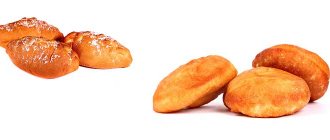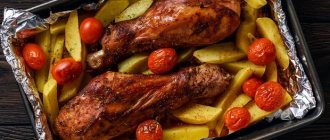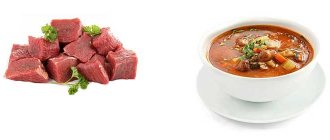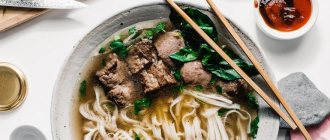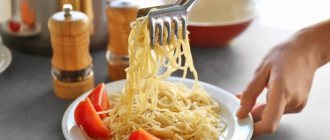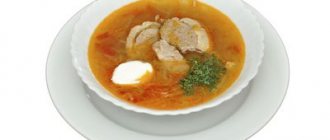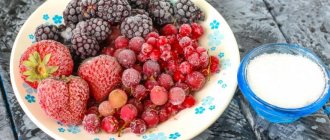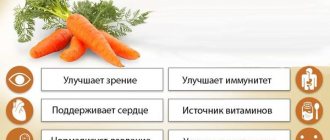Chemical composition and nutritional value
The chemical formula of the product includes:
- fats;
- proteins;
- carbohydrates;
- ash;
- water;
- vitamins;
- amino acids;
- minerals.
Among the amino acids, the following substances predominate:
- glutamine (4.087 g);
- aspartic (2.432 g);
- lysine (2.318 g);
- leucine (2.048 g).
A special role is played by glycine, methionine and arginine, which make up the important substance creatine. It increases endurance, adds strength, and reduces fatigue.
Boiled chicken contains a lot of protein, which is well absorbed by the stomach and is important for athletes who build muscle mass. The nutritional value of the product is 693 kJ. 100 grams contain 36% protein, 8% fat and 0% carbohydrates (daily value). Chicken contains 75.46 g of water and 0.96 g of ash. There is no sugar, fiber or starch in dietary meat. The amount of cholesterol is 70 mg.
https://youtu.be/https://www.youtube.com/watch?v=1M3my4JuDBg
_
Composition and beneficial properties of chicken fillet
Nutritional value of 100 g chicken:
- saturated fat (4 g);
- cholesterol (75 mg);
- calcium (11 mg);
- iron (0.9 mg);
- magnesium (20 mg);
- phosphorus (147 mg);
- potassium (189 mg);
- sodium (70 mg);
- zinc (1.3 mg).
Regarding vitamins:
- vitamin C;
- thiamine;
- riboflavin;
- niacin;
- vitamin B6;
- folate;
- vitamin B12;
- vitamin A;
- vitamin E;
- vitamin D;
- vitamin K.
Chickens raised in cramped and unhygienic farm conditions can be harmful, but if raised by a conscientious owner, the birds are healthy for the following reasons:
- Protein. An excellent low-fat source of protein that promotes muscle growth and development. Helps maintain a healthy body weight and promotes weight loss.
- Benefits for the heart. Eating chicken breast regulates the level of amino acids in the body; if it is too high, it can lead to heart disease.
- Phosphorus. The product is rich in phosphorus, an essential mineral that supports healthy teeth, bones, kidney function, liver, and nervous system.
- Abundant selenium content. This mineral, involved in metabolic processes, is important for the functioning of the thyroid gland, hormones, metabolism and immunity.
- Accelerated metabolism. The B-complex vitamins in chicken support healthy blood vessels, a high metabolic rate, and help burn calories, which helps maintain a healthy weight.
- Niacin . Another B vitamin, it helps protect against cancer and other forms of genetic (DNA) damage.
- Natural antidepressant. Eating domestic chicken will increase the level of serotonin in the brain, improve your mood, and relieve stress.
- Vision. Source of retinol, alpha and beta carotene and lycopene (all derived from vitamin A), are important for healthy vision.
- Healthy skin. Riboflavin (vitamin B2), found in chicken liver, reduces skin problems and restores dry, damaged skin.
- Strengthening bones. Thanks to the protein, eating chicken will help combat bone loss in old age and prevent osteoporosis or arthritis.
Calorie content and nutritional value of boiled chicken
The calorie content of boiled chicken is 180-200 kcal (per 100 g). If you cook meat with skin, the figure will increase to 218 kcal.
Per 100 g of product there are:
- 24.17 g protein;
- 7.61 g fat;
- 0.64 g carbohydrates.
Each part of a chicken carcass has its own calorie content:
- boiled chicken breast – 115 kcal;
- leg – 160-180 kcal;
- thigh – 180-210 kcal;
- wings – 180-190 kcal.
A sufficient amount of protein and the absence of carbohydrates allow the product to be used as the main ingredient for preparing dietary dishes. To reduce the calorie content of boiled chicken, it is advised:
- remove skin and fat from meat;
- pour out the broth 15-20 minutes after bubbles appear, and then cook it again;
- serve chicken with fresh tomatoes, cucumbers, sweet peppers and parsley to speed up the absorption of fats;
- do not use additional additives in the form of sauces and salty spices.
If possible, it is recommended to buy chicken breast rather than chicken legs.
The use of chicken meat in weight loss
White meat is always included in a healthy diet because it is lean and low in fat. Grilled skinless breast is included in any diet due to its low calorie content and protein content. Protein makes you feel full from fewer calories and helps you burn extra calories.
Increasing the amount of protein in the diet reduces total body fat and abdominal fat, but helps increase muscle mass and energy expenditure of the body during weight loss.
The amount of protein-rich foods, including chicken breast, that you need to eat for weight loss depends on individual needs:
- 90 g of protein products daily when consuming 1200 kcal/day;
- 120 g when following a 1400 kcal/day nutrition plan;
- 150 g of protein food when consuming 1600 kcal/day.
The Institute of Medicine considers it safe for adults to get up to 35% of their calories from protein, which amounts to:
- 105 g protein per 1200 kcal/day;
- 122.5 g per 1400 kcal/day;
- 140 g protein for 1600 kcal/day.
Tips for people who want to lose weight:
- choose lean cuts of meat;
- trim as much fat as possible before cooking and discard rendered fat after cooking;
- use healthier cooking methods: bake, stew, steam;
- Minimize the consumption of processed meat: sausages, ham, frankfurters.
Diet recipe
Salad with chicken, avocado and dried cranberries
For refueling:
- 1/4 tbsp. flour;
- salt;
- 1 tsp. dry mustard;
- 2 egg yolks;
- 1/2 cup milk;
- 1/3 cup vinegar (white or apple cider vinegar);
- 1 tbsp. l. olive oil.
For the salad:
- 1 chicken breast, cooked, cooled, diced;
- 1 cup dried cranberries, soaked overnight in water, drained;
- 1/2 tbsp. finely chopped celery;
- ground white pepper;
- chopped parsley;
- 4 or 5 avocados (1/2 avocado per person).
Mix flour, salt and mustard in a saucepan and place on the stove. Separately, beat the egg yolks with milk and vinegar. Slowly pour the mixture into the pan with the dry ingredients and whisk to combine. Cook over medium heat until mixture thickens, remove from heat. Add oil and stir. Cool to room temperature before use.
Place chicken, dried cranberries, celery, salt, pepper, and chopped parsley in a large bowl. Pour over the dressing and stir. Peel the avocado and chop. Place on top of the salad.
Content of vitamins and microelements
Boiled chicken meat contains the following vitamins:
- A;
- D;
- D3;
- E;
- K;
- IN 1;
- AT 2;
- B4;
- B5;
- B6;
- AT 12;
- RR.
The product contains the most vitamin B4 (72.4 mg). Choline deficiency in the body leads to increased irritability, decreased mental abilities and serious diseases such as gastrointestinal pathologies and sexual dysfunctions.
The product contains vital elements:
- sodium;
- phosphorus;
- potassium;
- calcium;
- iron;
- magnesium;
- manganese;
- zinc.
Boiled chicken contains the most potassium (180 mg) and phosphorus (150 mg). A lack of these substances leads to drowsiness, muscle pain, heart rhythm disturbances and hypotension. Nutrients maintain fluid balance in the body, regulate muscle activity and coordinate heart rhythm. They are sources of energy and support all biological processes in the body.
BJU and calorie content of chicken per 100 grams: boiled, fried, fillet, thighs
| Chicken | Calorie content, kcal | Proteins, grams | Fats, grams | Carbohydrates, grams |
| Boiled | 170 | 24 | 7,4 | 0,6 |
| Fried | 245 | 26 | 13 | 0,4 |
| Fillet | 113 | 23 | 2,7 | 0,55 |
| Hip | 160 | 20 | 9 | 1,5 |
https://youtu.be/https
://www.youtube.com/watch?v=1M3my4JuDBg
Daily consumption of poultry meat
Chicken meat is much more nutritious than, for example, beef. It is recommended for those who want to normalize weight. However, for good functioning of the body, one should include in the diet not only poultry, but also rabbit and pork meat.
Experts do not recommend eating more than 210-220 g per day. This is the optimal amount for an adult who is interested in sports or spends a lot of time doing physical labor.
For children under 3 years old, 75 g of chicken per day is enough. Boys and girls aged 4 to 7 years can eat up to 100-120 g of product. The same amount is suitable for an elderly person.
How to cook chicken correctly
Due to the fact that the calorie content of chicken fillet is minimal, it is used in all kinds of diets. However, combining it with other products is not prohibited. In addition, other parts of the bird can be eaten. When using legs or chicken breast, after rinsing, place them in a pan of water and bring to a boil. It is recommended that after 5 minutes of cooking, drain the water, pour cold clean water over the meat, and only then continue cooking it. As a result of these actions, you will be able to get rid of hormones and antibiotics if they were used in raising poultry. After this, the meat should be salted and cooked until tender, then cut into small pieces. An excellent addition to boiled chicken, including in the diet menu, would be rice, washed and boiled in salted water.
Related Products
Chicken Breast (184 cal) Cooked Chicken (237 cal) Chicken Breast (150 cal) Boiled Chicken (215 cal) Chicken Leg (233 cal) Chicken Wings (241 cal) White Meat Chicken (188 cal) Chicken fillet (150 cal) Skinless chicken (150 cal) Chicken cutlet (290 cal) Chicken steak (239 cal) Grilled chicken (193 cal) Chicken meat (181 cal) Fried chicken (284 cal) .) Rotisserie Chicken (150 cal) Chicken Thigh (226 cal) Whole Roast Chicken (227 cal) Baked Chicken (150 cal) Lean Chicken (143 cal) Skin-on Chicken (234 cal) Sauteed Chicken (217 kcal) Chicken skin (423 kcal) Canned chicken (155 kcal) Chicken gizzard (154 kcal) Minced chicken (189 kcal) Chicken heart (185 kcal) Chicken liver (170 kcal) Stewed chicken ( 210 cal) Raw chicken (172 cal) Chicken giblets (191 cal) Chicken leg (188 cal) Whole chicken (239 cal)
How many calories are in chicken?
Chicken legs, wings and backs are quite high in calories, so don't go heavy on them. Much depends on where the chicken was raised. For example: chicken that was raised on a farm without any chemical fertilizers is much higher in calories than its factory-produced compatriot. Homemade chicken will have about 200 kcal, while factory-grown chicken will have only 170.
Eat right and be healthy!
We also recommend
- Federal State Educational Institution of Higher Education "Ivanovo State Chemical-Technological University" (Ightu) Ivanovo Chemical-Technological University preparatory
- Registered bond Which bonds are issued to bearer only?
- Report on the completion of a foreign internship at the State University of Freiberg Mining Academy of a second-year master's student Karagulova K
- Faculties and specialties of TSU, passing scores
- FGBOU VPO "Ivanovo State Chemical Technology University" (IGHTU) FGBOU VPO "Ivanovo State Chemical Technology University"
- Voronezh State Medical University
Calorie content of individual parts of chicken
It is important to know that different parts of chicken have their own calorie content. For example, we give the calorie content in boiled form.
- Thighs - 158 Kcal/100g.
- Back - 306 Kcal/100g.
- Wings - 186 Kcal/100g.
- Breast – 113 Kcal/100g.
In the articles in this section you will find many interesting and healthy dishes that you can prepare at home and please your loved ones.
Get rid of dangerous papillomas FOREVER
A simple and proven way to get rid of papillomas and warts without dangerous consequences. Find out how >>
Chicken meat is the most common and often used as food. Various dishes are prepared from it (both first and second), salads, soufflés, and used as a filling in pies and baked goods. In addition to the fact that the product is very tasty, it is also healthy, especially for those who want to lose weight.
The benefits of chicken
If you are following a diet, chicken is definitely recommended for consumption. Firstly, meat contains many micro and macroelements, such as iron, calcium, magnesium, selenium, copper, phosphorus and even amino acids. It should be noted that chicken meat contains vitamins A, B and E. The combination of consuming micro and macroelements will help make bones strong, and after a while you will notice that the nail plates have become stronger, and accelerated nail growth is also noted. However, the vitamin composition is retained in the meat provided that it has not been frozen, so in the store you should give preference to chilled chicken.
Chicken meat is rich in protein, which helps increase muscle mass, so chicken breast is included in the mandatory diet of athletes. It is noted that the consumption of boiled meat energizes, and in combination with training and proper nutrition, helps to lose excess weight.
